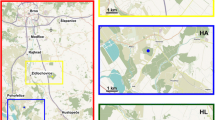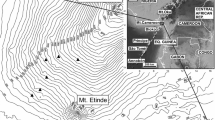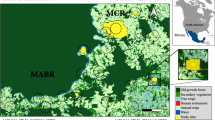Abstract
Photosynthetic productivity is a key determinant of the abundance and distribution of biodiversity around the world. The effect of this productivity on the distribution patterns of mammals is frequently invoked; however, it is seldom measured directly. In this study, we used Sherman live traps set in dry and rainy seasons across a 2300-m elevation gradient in southwestern Mexico to assess small rodent species distributions, and to relate these patterns to habitat structure, climate, and a well-accepted measure of photosynthetic productivity: the normalized difference vegetation index (NDVI). While habitat structure and climate helped explain some of the patterns observed, NDVI proved to be the most important contributing variable for most of the distribution models. We also found that partitioning the gradient-distribution model by trapping season revealed strong differences in terms of the effect of NDVI and the other explanatory variables. For example, lower elevations were associated with seasonal and year-round reductions in rodent diversity and were composed almost exclusively of granivore-based species assemblages. By contrast, the middle and upper elevations were more species rich, less affected by seasonality, and characterized by omnivorous species. Our results suggest that the positive productivity–diversity relationship found may be due, at least in part, to increased food resources and niche opportunities at more productive elevations. Increased diversity at the higher elevations may also be partially due to reductions in competition that result from productivity increases, as well as from the broader spectrum of feeding guild representation that it and the lack of seasonality allow.



Similar content being viewed by others
References
Acharya BK, Sanders NJ, Vijayan L, Chettri B (2011) Elevational gradients in bird diversity in the eastern Himalaya: an evaluation of distribution patterns and their underlying mechanisms. PLoS One 6:e29097. https://doi.org/10.1371/journal.pone.0029097
Alexander LF, Riddle BR (2005) Phylogenetics of the new world rodent family Heteromyidae. J Mammal 86:366–379. https://doi.org/10.1644/BER-120.1
Álvarez-Castañeda ST, Álvarez T, González-Ruiz N (2015) Guía para la identificación de los mamíferos de México en campo y laboratorio. Centro de Investigaciones Biológicas del Noroeste, S. C. y Asociación Mexicana de Mastozoología, A. C., México
Anderson TM, White S, Davis B, Erhardt R, Palmer M, Swanson A, Kosmala M, Packer C (2016) The spatial distribution of African savannah herbivores: species associations and habitat occupancy in a landscape context. Phil Trans R Soc B Biol Sci. https://doi.org/10.1098/rstb.2015.0314
Andrews P, O’Brien EM (2000) Climate, vegetation, and predictable gradients in mammal species richness in southern Africa. J Zool 251:205–231. https://doi.org/10.1111/j.1469-7998.2000.tb00605.x
Bachman S, Baker WJ, Brummitt N, Dransfield J, Moat J (2004) Elevational gradients, area and tropical island diversity: an example from the palms of New Guinea. Ecography 27:299–310. https://doi.org/10.1111/j.0906-7590.2004.03759.x
Bailey SA, Horner-Devine MC, Luck G, Moore LA, Carney KM, Anderson S, Betrus C, Fleishman E (2004) Primary productivity and species richness: relationships among functional guilds, residency groups and vagility classes at multiple spatial scales. Ecography 27:207–217. https://doi.org/10.1111/j.0906-7590.2004.03631.x
Baker RH (1952) Geographic range of Peromyscus melanophrys, with description of a new subspecies. Univ Kansas Publ Mus Nat Hist 5:251–258
Bartón K (2018) MuMIn: multimodel inference, R Package version 1.42.1. http://CRAN.R-project.org/package=MuMIn. Accessed 4 Sept 2018
Bateman BL, Kutt AS, Vanderduys EP, Kemp JE (2010) Small-mammal species richness and abundance along a tropical altitudinal gradient: an australian example. J Trop Ecol 26:139–149. https://doi.org/10.1017/S0266467409990460
Bowman TRS, McMillan BR, St. Clair SB (2017) A comparison of the effects of fire on rodent abundance and diversity in the Great Basin and Mojave Deserts. PLoS One 12:e0187740. https://doi.org/10.1371/journal.pone.0187740
Brooks TM, Mittermeier RA, da Fonseca GAB, Gerlach J, Hoffmann M, Lamoreux JF, Mittermeier CG, Pilgrim JD, Rodrigues ASL (2006) Global biodiversity conservation priorities. Science 313:58–61. https://doi.org/10.1126/science.1127609
Brown JH (1973) Species diversity of seed-eating desert rodents in sand dune habitats. Ecology 54:775–787. https://doi.org/10.2307/1935672
Brown JH (1995) Macroecology. University of Chicago Press, Chicago
Brown JH (2001) Mammals on mountainsides: elevational patterns of diversity. Global Ecol Biogeogr 10:101–109. https://doi.org/10.1046/j.1466-822x.2001.00228.x
Brown JH, Ernest SK (2002) Rain and rodents: complex dynamics of desert consumers: Although water is the primary limiting resource in desert ecosystems, the relationship between rodent population dynamics and precipitation is complex and nonlinear. Bioscience 52:979–987. https://doi.org/10.1641/0006-3568(2002)052%5b0979:RARCDO%5d2.0.CO;2
Bullock SH, Solis-Magallanes JA (1990) Phenology of canopy trees of a tropical deciduous forest in Mexico. Biotropica 22(1):22–35
Burnham KP, Anderson DR (2002) Model selection and inference: a practical information-theoretic approach. Springer, New York
Ceballos G, Oliva G (2005) Los mamíferos silvestres de México. Fondo de Cultura Económica, México
Chong DL, Mougin E, Castellu-Etchegorry JP (1993) Relating the global vegetation index to net primary productivity and actual evapotranspiration over Africa. Int J Remote Sens 14:1517–1546. https://doi.org/10.1080/01431169308953984
Cramer W, Kicklighter DW, Bondeau A, Moore B, Churkina G, Nemry B, Ruimy A, Schloss AL (1999) Comparing global models of terrestrial net primary productivity (NPP): overview and key results. Glob Chang Biol 5:1–15. https://doi.org/10.1046/j.1365-2486.1999.00009.x
Davidson AD, Lightfoot DC (2007) Interactive effects of keystone rodents on the structure of desert grassland arthropod communities. Ecography 30:515–525. https://doi.org/10.1111/j.0906-7590.2007.05032.x
Dreiss LM, Burgio KR, Cisneros LM, Klingbeil BT, Patterson BD, Presley SJ, Willig MR (2015) Taxonomic, functional, and phylogenetic dimensions of rodent biodiversity along an extensive tropical elevational gradient. Ecography 38:876–888. https://doi.org/10.1111/ecog.00971
Escobar F, Halffter G, Arellano L (2007) From forest to pasture: an evaluation of the influence of environment and biogeography on the structure of beetle (Scarabaeinae) assemblages along three altitudinal gradients in the Neotropical region. Ecography 30:193–208. https://doi.org/10.1111/j.0906-7590.2007.04818.x
Espinoza E, Sánchez I, García M, Lorenzo C (2006) Análisis de la distribución de roedores de la Familia Muridae en el Sur de México. In: Vázquez-Domínguez E, Hafner DJ (eds) Genética y mamíferos mexicanos: presente y futuro. New Mexico Museum of Natural History and Science Bulletin, Albuquerque, pp 47–54
Evans KL, James NA, Gaston KJ (2006) Abundance, species richness and energy availability in the North American avifauna. Global Ecol Biogeogr 15:372–385. https://doi.org/10.1111/j.1466-822X.2006.00228.x
Ferro I (2013) Rodent endemism, turnover and biogeographical transitions on elevation gradients in the northwestern Argentinian Andes. Mamm Biol 78:322–331. https://doi.org/10.1016/j.mambio.2013.02.005
Figueredo CC, Giani A (2001) Seasonal variation in the diversity and species richness of phytoplankton in a tropical eutrophic reservoir. Hydrobiologia 445:165–174. https://doi.org/10.1023/a:1017513731393
Fu C, Hua X, Li J, Chang Z, Pu Z, Chen J (2006) Elevational patterns of frog species richness and endemic richness in the Hengduan Mountains, China: geometric constraints, area and climate effects. Ecography 29:919–927. https://doi.org/10.1111/j.2006.0906-7590.04802.x
Gillman LN, Wright SD (2006) The influence of productivity on the species richness of plants: a critical assessment. Ecology 87:1234–1243. https://doi.org/10.1890/0012-9658(2006)87%5b1234:tiopot%5d2.0.co;2
Hawkins BA, Porter EE, Felizola Diniz-Filho JA (2003) Productivity and history as predictors of the latitudinal diversity gradient of terrestrial birds. Ecology 84:1608–1623. https://doi.org/10.1890/0012-9658(2003)084%5b1608:PAHAPO%5d2.0.CO;2
Heaney LR (2001) Small mammal diversity along elevational gradients in the Philippines: an assessment of patterns and hypotheses. Glob Ecol Biogeogr 10:15–39. https://doi.org/10.1046/j.1466-822x.2001.00227.x
Hiiesalu I, Bahram M, Tedersoo L (2017) Plant species richness and productivity determine the diversity of soil fungal guilds in temperate coniferous forest and bog habitats. Mol Ecol 26:4846–4858. https://doi.org/10.1111/mec.14246
Hsieh TC, Ma KH, Chao A (2016) iNEXT: interpolation and extrapolation for species diversity. R package version 2.0.17. http://chao.stat.nthu.edu.tw/blog/software-download/
Hu Y, Jin K, Huang Z, Ding Z, Liang J, Pan X, Hu H, Jiang Z (2017) Elevational patterns of non-volant small mammal species richness in Gyirong Valley, Central Himalaya: evaluating multiple spatial and environmental drivers. J Biogeogr 44:2764–2777. https://doi.org/10.1111/jbi.13102
Hunt JL, Morris JE, Best TL (2004) Nyctomys sumichrasti. Mamm Species 754:1–6. https://doi.org/10.1644/754
Hurlbert AH, Haskell JP (2003) The effect of energy and seasonality on avian species richness and community composition. Am Nat 161:83–97. https://doi.org/10.1086/345459
Kelt DA (1999) Assemblage structure and quantitative habitat relations of small mammals along an ecological gradient in the Colorado Desert of southern California. Ecography 22:659–673. https://doi.org/10.1111/j.1600-0587.1999.tb00515.x
Kerr JT, Ostrovsky M (2003) From space to species: ecological applications for remote sensing. Trends Ecol Evol 18:299–305. https://doi.org/10.1016/S0169-5347(03)00071-5
Körner C (2007) The use of ‘altitude’ in ecological research. Trends Ecol Evol 22:569–574. https://doi.org/10.1016/j.tree.2007.09.006
Kraft NJB, Comita LS, Chase JM, Sanders NJ, Swenson NG, Crist TO, Stegen JC, Vellend M, Boyle B, Anderson MJ, Cornell HV, Davies KF, Freestone AL, Inouye BD, Harrison SP, Myers JA (2011) Disentangling the drivers of β diversity along latitudinal and elevational gradients. Science 333:1755–1758. https://doi.org/10.1126/science.1208584
Li JS, Song YL, Zeng ZG (2003) Elevational gradients of small mammal diversity on the northern slopes of Mt. Qilian, China. Glob Ecol Biogeogr 12:449–460. https://doi.org/10.1046/j.1466-822X.2003.00052.x
Lomolino MV (2001) Elevation gradients of species-density: historical and prospective views. Glob Ecol Biogeogr 10:3–13. https://doi.org/10.1046/j.1466-822x.2001.00229.x
Magurran AE (1988) Biological diversity and its measurements. Princeton University Press, Princenton
McCain CM (2004) The mid-domain effect applied to elevational gradients: species richness of small mammals in Costa Rica. J Biogeogr 31:19–31. https://doi.org/10.1046/j.0305-0270.2003.00992.x
McComb WC (2003) Ecology of coarse wood debris and its role as habitat for mammals. In: Zabel CJ, Anthony RG (eds) Mammal community dynamics. Management and conservation in the coniferous forests of Western North America. Cambridge University Press, Cambridge, pp 374–404
Moen J, Collins SL (1996) Trophic interactions and plant species richness along a productivity gradient. Oikos 76:603–607. https://doi.org/10.2307/3546357
Moreno CE, Halffter G (2000) Assessing the completeness of bat biodiversity inventories using species accumulation curves. J Appl Ecol 37:149–158. https://doi.org/10.1046/j.1365-2664.2000.00483.x
Nichols DW, Smith HD, Baker MF (1975) Rodent populations, biomass, and community relationships in Artemisia tridentata, Rush Valley, Utah. Great Basin Nat 35:191–202
Niedzialkowska M, Konczak J, Czarnomska S, Jedrzejewska B (2010) Species diversity and abundance of small mammals in relation to forest productivity in northeast Poland. Ecoscience 17:109–119. https://doi.org/10.2980/17-1-3310
Novillo A, Ojeda RA (2014) Elevation patterns in rodent diversity in the dry Andes: disentangling the role of environmental factors. J Mamm 95:99–107. https://doi.org/10.1644/13-MAMM-A-086.1
Peterson A, Canseco-Márquez L, Contreras-Jiménez JL, Escalona-Segura G, Flores-Villela O, García-López J, Hernández-Baños B, Jiménez-Ruiz C, León-Paniagua L, Mendoza-Amaro S, Navarro-Sigüenza A, Sánchez-Cordero V, Willard D (2004) A preliminary biological survey of Cerro Piedra Larga, Oaxaca, Mexico: birds, mammals, reptiles and amphibians, and plants. Anal Inst Biol Ser Zool 75:439–466
R Core Development Team (2017) R: a language and environment for statistical computing. R Foundation for Statistical Computing, Vienna, Austria. http://www.R-project.org
Rickart EA, Heaney LR, Balete DS, Tabaranza BR (2011) Small mammal diversity along an elevational gradient in northern Luzon, Philippines. Mamm Biol 76:12–21. https://doi.org/10.1016/j.mambio.2010.01.006
Rowe RJ (2009) Environmental and geometric drivers of small mammal diversity along elevational gradients in Utah. Ecography 32:411–422. https://doi.org/10.1111/j.1600-0587.2008.05538.x
Sánchez-Cordero V (2001) Elevation gradients of diversity for rodents and bats in Oaxaca, Mexico. Glob Ecol Biogeogr 10:63–76. https://doi.org/10.1046/j.1466-822x.2001.00235.x
Schuur EA, Matson PA (2001) Net primary productivity and nutrient cycling across a mesic to wet precipitation gradient in Hawaiian montane forest. Oecologia 128:43–442. https://doi.org/10.1007/s004420100671
Southwood RT, Wint GR, Kennedy C, Greenwood S (2004) Seasonality, abundance, species richness and specificity of the phytophagous guild of insects on oak (Quercus) canopies. Eur J Entomol 101:43–50. https://doi.org/10.14411/eje.2004.011
Srivastava D, Lawton John H (1998) Why more productive sites have more species: An experimental test of theory using tree-hole communities. Am Nat 152:510–529. https://doi.org/10.1086/286187
Stevens RD (2013) Gradients of bat diversity in Atlantic forest of South America: environmental seasonality, sampling effort and spatial autocorrelation. Biotropica 45:764–770. https://doi.org/10.1111/btp.12056
Sullivan TP, Sullivan DS, Lindgren PMF, Ransome DB (2012) If we build habitat, will they come? Woody debris structures and conservation of forest mammals. J Mamm 93:1456–1468. https://doi.org/10.1644/11-MAMM-A-250.1
Sweet SK, Asmus A, Rich ME, Wingfield J, Gough L, Boelman NT (2015) NDVI as a predictor of canopy arthropod biomass in the Alaskan arctic tundra. Ecol Appl 25:779–790. https://doi.org/10.1890/14-0632.1
Tapia-Ramírez G, López-González C, González-Romero A, Hernández-Betancourt SF (2012) Diversidad de roedores y su relación con la heterogeneidad ambiental en la cuenca del río Nazas, Durango, México. In: Cervantes FA, Ballesteros-Barrera C (eds) Estudios sobre la biología de roedores silvestres mexicanos. Universidad Nacional Autónoma de México, Ciudad de México, pp 59–70
Terborgh J (1977) Bird species diversity on an Andean elevational gradient. Ecology 58:1007–1019. https://doi.org/10.2307/1936921
Thibault KM, Ernest SKM, White EP, Brown JH, Goheen JR (2010) Long-term insights into the influence of precipitation on community dynamics in desert rodents. J Mammal 91:787–797. https://doi.org/10.1644/09-MAMM-S-142.1
Trejo I (2004) Clima. In: García-Mendoza AJ, Ordoñez MJ, Briones-Salas M (eds) Biodiversidad de Oaxaca. Instituto de Biología, UNAM-Fondo Oaxaqueño para la Conservación de la Naturaleza-World Wildlife Fund, México, pp 67–85
Tucker CJ (1979) Red and photographic infrared linear combinations for monitoring vegetation. Remote Sens Environ 8:127–150. https://doi.org/10.1016/0034-4257(79)90013-0
Tucker CJ, Sellers PJ (1986) Satellite remote sensing of primary production. Int J Remote Sens 7:1395–1416. https://doi.org/10.1080/01431168608948944
Valone TJ, Schutzenhofer MR (2007) Reduced rodent biodiversity destabilizes plant populations. Ecology 88:26–31. https://doi.org/10.1890/0012-9658(2007)88%5b26:RRBDPP%5d2.0.CO;2
Waide RB, Willig MR, Steiner CF, Mittelbach G, Gough L, Dodson SI, Juday GP, Parmenter R (1999) The relationship between productivity and species richness. Annu Rev Ecol Syst 30:257–300. https://doi.org/10.1146/annurev.ecolsys.30.1.257
Wen Z, Wu Y, Du Y, Xia L, Ge D, Yang Q, Chen L (2014) Seasonal change of species diversity patterns of non-volant small mammals along three subtropical elevational gradients. Biotropica 46:479–488. https://doi.org/10.1111/btp.12123
Wickham H (2009) ggplot2: elegant graphics for data analysis. Springer, New York
Williams SE, Marsh H, Winter J (2002) Spatial scale, species diversity, and habitat structure: small mammals in Australian tropical rain forest. Ecology 83:1317–1329. https://doi.org/10.1890/0012-9658(2002)083%5b1317:sssdah%5d2.0.co;2
Williams SE, Shoo LP, Henriod R, Pearson RG (2010) Elevational gradients in species abundance, assemblage structure and energy use of rainforest birds in the Australian wet tropics bioregion. Austral Ecol 35:650–664. https://doi.org/10.1111/j.1442-9993.2009.02073.x
Wilson DE, Reeder D (2005) Mammal Species of the World. A taxonomic and geographic reference, 3rd edn. Johns Hopkins University Press, Baltimore
Wilson MV, Schmida A (1984) Measuring beta diversity with presence-absence data. J Ecol 72:1055–1064. https://doi.org/10.2307/2259551
Wu Y, Yang Q, Wen Z, Xia L, Zhang Q, Zhou H (2013) What drives the species richness patterns of non-volant small mammals along a subtropical elevational gradient? Ecography 36:185–196. https://doi.org/10.1111/j.1600-0587.2011.07132.x
Zuur AF, Leno EN, Smith GM (2007) Analyzing ecological data. Springer, New York
Acknowledgements
We thank M. Briones-Salas for support with field methods, V. Sánchez-Cordero for helpful suggestions that improved the study, and to the communities of San Pedro Jilotepec and Magdalena Tequisistlán for allowing us to conduct the field work in their territory.
Funding
ARB acknowledges the Mexican National Commission of Science and Technology (CONACyT) for the dissertation grant (#237201) that made this research possible.
Author information
Authors and Affiliations
Contributions
Both authors contributed equally to designing the study. ARB collected the data, performed the initial analyses and wrote the first draft. Both authors contributed equally to subsequent revisions of the analyses and manuscript.
Corresponding author
Ethics declarations
Conflict of interest
Authors declare no conflict of interests.
Additional information
Communicated by Janne Sundell.
This study helps clarify the altitudinal relationship between small mammal diversity, seasonality and primary productivity in a tropical setting.
Electronic supplementary material
Below is the link to the electronic supplementary material.
Rights and permissions
About this article
Cite this article
Ramírez-Bautista, A., Williams, J.N. The importance of productivity and seasonality for structuring small rodent diversity across a tropical elevation gradient. Oecologia 190, 275–286 (2019). https://doi.org/10.1007/s00442-018-4287-z
Received:
Accepted:
Published:
Issue Date:
DOI: https://doi.org/10.1007/s00442-018-4287-z




